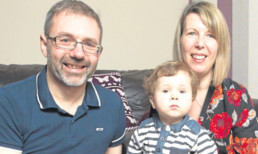
Medics have named a new technique after a boy whose life was saved by pioneering surgery.
Tiny three-year-old Frazer Orr has inspired the “Frazer technique” which is now being taught to top doctors as far away as Japan and Chile.
He had unique surgery to rectify a life-threatening condition which was causing his heart to throttle him.
One of the UK’s leading surgeons, Professor Martin Elliott, from Great Ormond Street Hospital in London, was the first person to carry out the procedure.
He said he had “never had a case like this in 37 years” of specialist heart and lung surgery and said the op was “a nightmare”.
A team of more than 20 specialists assisted him to perform a gruelling six-hour operation on Frazer, from Livingston, West Lothian.

Stents had been placed in the little boy’s airway to help him to breathe, but his life was at risk when one of them eroded through into his gullet.
The professor said: “It was a nightmare, it had eroded and was also obstructing his airway. We chopped out that part, repaired it and went on to put a patch on his heart.”
The drama unfolded after Frazer was diagnosed with having an aortic heart valve that was so enlarged, it was affecting his ability to breathe.
“He was being throttled from the inside,” said dad Sandy, 43.
His parents only discovered he had a lethal cardiac condition after Frazer suddenly stopped breathing and turned blue on a day trip out in the car.
Doctors later discovered his windpipe was so floppy it was likely to close at any time.
The tiny “scaffolding” stents were needed to keep it open, but when one of them moved it threatened to destroy his gullet and windpipe, killing him. The complication was so rare no doctor had ever corrected it before.
The family were told their only hope was the team at Great Ormond Street Hospital and Professor Elliott.
“He was our baby’s only chance of survival,” said dad.
Mum Kirsty, 40, said: “We’re delighted Frazer is still with us thanks to the incredible doctors and their amazing ingenuity. They really are miracle workers. It’s amazing to think surgeons across the world are learning a life saving technique named after our son.”
Frazer, who has regular check ups following the major surgery, has now learnt to walk and is loving life as a “normal wee boy”.
“He now has the chance to be a healthy child and we’ve become a normal family,” Kirsty adds. “We always believed he would survive.”Frazer’s parents Kirsty and Sandy were given a vital lifeline of help by The Sick Children’s Trust. The charity gave them free accommodation in London near Great Ormond Street. “They were there to help at a very worrying time in our livesand were kindness itself,” said Sandy. http://www.sickchildrenstrust.org

Enjoy the convenience of having The Sunday Post delivered as a digital ePaper straight to your smartphone, tablet or computer.
Subscribe for only £5.49 a month and enjoy all the benefits of the printed paper as a digital replica.
Subscribe